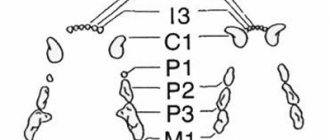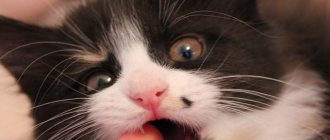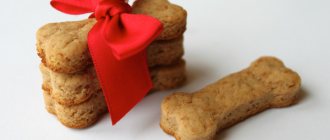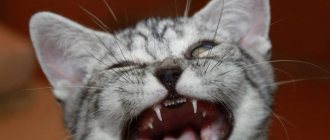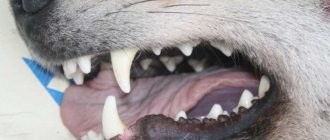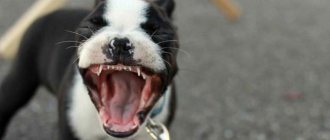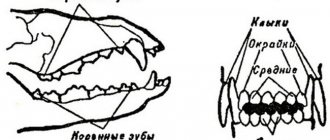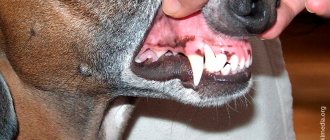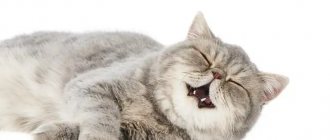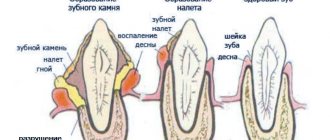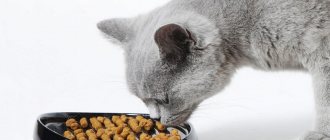When do kittens' teeth change? Small mustaches sometimes reach their new owners very early. And you need to know a lot about their development, body characteristics and care in order to raise a beautiful and healthy animal. Including, of course, you need to be aware of such an issue as the change of baby teeth in kittens - at what age this happens and with what symptoms. We will talk about this today.
Cat teeth are a formidable weapon of the ancestral wild cat and a “tool” for high-quality nutrition of the modern domestic cat. Owners who care about their pet (or pet, if we are talking about a cat) should monitor their condition from the moment the pussy appears in the house. And not just observe, but take care, as dentists say, “of the oral cavity”!
Features of tooth growth in kittens
Many owners of small kittens are interested in the forums: do purrs have milk teeth and how many times a cat’s teeth change during their life. To find the answer to these questions, you need to know the characteristics of teeth changing in cats.
At what age do kittens get teeth?
Kittens are born mostly toothless. Their baby teeth erupt 1–2 weeks after birth. By two months, the little purr already has 26 scars. They grow slowly and this process is naturally accompanied by itching.
During this period, cats are quite restless - they constantly strive to chew anything in their field of vision, thus scratching their itchy gums.
When do kittens change teeth?
The change of teeth in small kittens occurs once in a lifetime. Baby teeth fall out and are replaced with permanent new ones. The table shows in what order and at what time periods purrs under one year of age can change their teeth:
| N p/p | Kinds | Approximate shift dates | Number of teeth in an adult cat |
| 1 | Incisors | 4–5 month | 12 |
| 2 | Fangs | 4–6 month | 4 |
| 3 | Premolars | 5–6 month | 10 |
| 4 | Molars | Last ten days of the sixth month | 4 |
If the incisors and fangs fall out in a pet older than one year of age, this indicates the development of some kind of pathology.
Do kittens lose their baby teeth?
Between the ages of three and five months, pets begin to lose their baby teeth. In general, changing teeth is a natural process. True, this period is quite long - it usually ends by seven months.
Symptoms of teeth changing and erupting
Teething, as well as the replacement of milk teeth with permanent teeth in representatives of the cat family, is often accompanied by the following symptoms:
- ptyalism;
- decreased physical activity;
- mild excitability;
- bad breath;
- increase in body temperature by 0.5-1C;
- the emergence of a need to chew various objects.
Based on these signs, a loving owner can easily understand that the kitten has begun the process of teething. It is important for each owner to determine the age of change of incisors and canines in cats in order to avoid various health problems for the pet.
Features of feeding a kitten during the period of dentition change
During this difficult period for a kitten, special attention should be paid to the immune system, namely its protection and strengthening. The pet must be provided with a complete, balanced diet. Products in the diet should be enriched with vitamins and mineral elements necessary not only for strengthening the body's defenses, but also for the active growth of new, permanent healthy and strong teeth.
The basis of the daily diet is foods enriched with calcium and phosphorus. These are elements that promote the proper growth of strong and healthy bone tissue, including teeth. The menu should include dairy and fermented milk products, and porridge is a must. Cereals boiled in milk or water are a source of carbohydrates, which are necessary to meet the energy needs of the animal's body.
It is also necessary to give the baby meat, but lean meat, and it is advisable to cut it into small pieces. If meat is given raw, it must be pre-frozen so that pathogenic bacteria, viruses and intestinal parasites are completely destroyed under the influence of low temperatures.
You should not overuse fish; it is enough to give it no more than 1, maximum 2 times a week.
To replenish all the necessary vitamins and minerals, it is recommended to give your pet commercial dry food during the period of replacement of baby teeth. Moreover, commercial diets are produced that are specially designed for kittens during the period of loss of milk teeth. Such nutrition performs several functions at once - the animal receives all the necessary microelements, hard granules have a beneficial effect on the gums, accelerating the process of loss of baby teeth and the growth of permanent incisors.
During the period of growing new teeth, the kitten experiences quite painful sensations, so the owner must pay as much attention as possible to alleviate the pet’s condition. You need to constantly play with the kitten, so it will be distracted from the unpleasant sensations in the mouth and fall asleep better at night.
There is no need to scold your pet for chewing furniture, especially sofa arms. It is better to buy special toys. This is the best remedy to help a kitten during teething.
Some kittens try to chew on their owner's hands, but such actions must be stopped immediately so that this does not become a habit, since the cat will continue to do this into adulthood.
If the kitten experiences quite severe pain, special dental gels will help. But they only give a short-term effect, so they should be applied in the evening before bed so that the animal can fall asleep without problems.
It is not recommended to purchase special teethers intended for people. Kittens' teeth are quite sharp, so they can easily bite off a piece of rubber and swallow it, which can result in digestive problems.
If the animal does not want to use specialized toys, but continues to chew on household items, the owners need to be patient, regularly explain and show the pet that there are special items for its needs, and everything else is taboo. If this is not done, after replacing baby teeth with permanent ones, the habit of damaging shoes and furniture will remain.
Also watch the video of kittens changing teeth:
Kitten care
When replacing milk teeth with permanent ones, caring owners should create special conditions for keeping the cat, its nutrition, oral hygiene and general purring behavior.
Kitten oral hygiene
A cat should be accustomed to cleaning from the first months of life, so as not to be tormented later with an adult cat. Veterinarians advise starting with a game - let the little purr get used to his toothbrush. This way he won't be afraid of her.
Later, the kitten will even appreciate the opportunity to scratch his itchy gums on the bristly surface of the brush.
Hygiene procedures for the kitten's oral cavity should be performed 1-2 times a month. This procedure is an excellent prevention of periodontitis and tartar.
Nutritional Features
A small pet should be fed taking into account its age characteristics, regardless of the replacement of fangs. Caring owners should know that the health of a kitten’s oral cavity is promoted by food rich in phosphorus, calcium, as well as vitamins A and D. The cat will benefit from: boiled lean meat and fish, rice and oatmeal, milk, kefir, cottage cheese, pumpkin and zucchini.
When feeding industrial food, preference should be given to products made directly for kittens. Such food contains a balanced vitamin and mineral complex, specially designed for the growth of a young cat's body.
By eating such food, the kitten receives the proper amount of microelements necessary for oral health.
How to behave with a pet
Itching in the gum area during the eruption of incisors and fangs always causes stress in kittens. During this period, owners are encouraged to correct the cat's behavior. You should not allow your cat to chew on anything - this can harm the baby’s health.
During these several months, it is better not to vaccinate the purr, so that the vaccination does not harm its health.
Formation of dental occlusion from the birth of a cat
A complete set of baby teeth in cats consists of 26 pieces. The onset of gum eruption occurs between 2-3 weeks from birth (usually closer to 3 weeks). A complete primary dentition is formed by 6 weeks (maximum by 8). The appearance of the first sharp teeth is a signal that the kittens can begin to be introduced to “chewable” complementary foods.
Teething order:
Healthy baby teeth in a kitten
- incisors (2-4 weeks from birth);
- fangs (3-4 weeks);
- premolars (6-8 weeks).
Cats' milk teeth are whiter and thinner than their permanent teeth.
Possible complications when changing teeth
The replacement of baby teeth with permanent ones is a common natural phenomenon in kittens. It is mostly asymptomatic. Unless your gums may turn slightly red. However, monitoring of the kitten's condition will be required.
Contacting a veterinary clinic is necessary if you notice non-healing festering wounds in the mouth, a bad mood in the cat, loss of appetite, suppuration on the gums, or the appearance of wounds near the grown permanent incisors or fangs.
A doctor’s help is also needed if new teeth erupt before baby teeth fall out.
Oral diseases in cats
A big problem when teething with incisors in cats is severe inflammation of the gums.
Gum inflammation
Prolonged inflammation of the gums in cats when changing teeth is characterized by the following signs:
- restless cat behavior;
- refusal to eat due to pain in the mouth;
- ptyalism;
- swelling and noticeable redness of the gums.
When to contact a veterinarian
To avoid possible negative consequences and complications during teething, you need to carefully monitor the condition and behavior of the animal and, if necessary, promptly seek help from a veterinarian. The help of a specialist is necessary if you find:
- suppuration of the wound in the gum at the site where the baby tooth fell out;
- severe pain that prevents the baby from falling asleep, tossing and turning in his sleep, plaintive meowing and moaning;
- lethargy and apathy, remaining in a lying position for most of the day, lack of response to the owner’s offer to play;
- refusal to eat for 2 days or more;
- severe inflammatory process on the gums;
- increasing unpleasant odor from the mouth;
- the new tooth grows incorrectly (for example, to the side), which is why it constantly scratches the gum;
- the baby tooth could not fall out on its own, the gums underneath it began to become inflamed, and a purulent lesion appeared;
- the animal does not go to the toilet for more than a day;
- The baby teeth partially fell out, although half of them had already been replaced by permanent ones, and the process of loss stopped.
The fact that a cat does not go to the toilet for a day or more may be caused by the fact that he ate something hard in an attempt to relieve pain in the gums, and this object “stood up” in the middle of the stomach, disrupting the process of digestion and intestinal motility.
Complications that arise during the process of replacing baby teeth can be treated either with medication or have to resort to surgical intervention, but help must be provided to the pet immediately. For example, the presence of infectious inflammation can cost a pet not only its health, but also its life.
Indications for tooth extraction
Surgical intervention to remove problematic baby teeth that do not fall out on their own is carried out if there are indications:
- the baby tooth, displaced by the new permanent incisor, moves to the side and leads to injury to the oral mucosa;
- development of dental disease - periodontal disease;
- bite deformation;
- double row of teeth.
Any deviations in the process of replacing baby teeth are associated in most cases with the characteristics of the bite. There is also a genetic predisposition to the development of such problems, so the pet must be regularly shown to the veterinarian during this period in order to be able to provide timely assistance.
Causes of tooth loss in adult cats
Causes of loss of fangs with incisors in an adult cat:
- injuries or infectious diseases in the oral cavity;
- weakened immune system;
- lack of vitamins;
- diabetes;
- tartar;
- metabolic problems;
- pregnancy;
- therapy with hormonal veterinary drugs (antibiotics or contraceptives);
- incorrectly formed bite;
- stomatitis, periodontal disease, gingivitis, or other dental diseases;
- serious stomach or intestinal problems;
- oncology.
There is an opinion that cats lose teeth due to age and their loss in pets over 8 years old is a natural phenomenon. This version is wrong.
Cats lose their incisors and canines from old age when they reach the age of 20, but rarely does any individual live to such years.
How to help a cat
If a cat's teeth are falling out, owners should monitor the cat for changes in behavior and additional pathological symptoms. Any signs noted must be reported to your veterinarian. This data will be required for the correct diagnosis and subsequent prescription of effective treatment for the furry patient.
Depending on the cause of the loss of incisors and fangs, the doctor will be able to offer the following methods of solving the problem:
- Prescribing a special diet.
- Prescription of immunostimulants.
- Treatment of gum diseases.
- Removal of tartar under “premedication” or general anesthesia.
- Treatment of the underlying disease.
Cat jaw structure
Typically, the jaws of cats are well developed and have a peculiarity: the movement of the lower jaw occurs only vertically. The animal bites the food, as if cutting it.
Each tooth has enamel, dentin, pulp and root (1-3), as well as its own role. Let's open the cat's mouth and see that in front there are 12 incisors for holding prey in the mouth.
Next are long fangs, firmly seated in the bone: two below, two above. Their function is to grind food, and they also help in hunting and self-defense.
Behind the canines, premolars and molars are visible, which allow them to chew food and grind bones.
